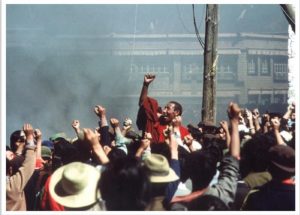
1987 Protest photo
Thirty years ago a wave of uprisings against the Chinese occupation swept through Tibet. The Tibet support group Tibet Watch has issued a report commemorating the events of that time and describing their effects. This is contained in a document entitled 30 Years of Resistance: The Legacy of the 1987 Lhasa Protests*.
The report gives the background to the narrative. Following a period of severe Chinese repression from 1959 to 1980 there was a time of relatively enlightened rule. Robert Barnett, director of the Modern Tibetan Studies Programme at Columbia University and author of Lhasa: Streets with Memories, is quoted as saying, “the reforms did create an opportunity for rebuilding from the ground up the rudiments of a Tibetan civil society devastated by two decades of communism”.
However in September 1987 China rejected His Holiness the Dalai Lama’s proposed peace plan and were publicly critical of him. This sparked the first demonstration which took place on September 27, 1987. Dissent continued in various forms until March 7, 1989 when the declaration of martial law effectively ended protest action.
The core of the report is a set of photographs that are previously unpublished, mainly for security reasons. The images mainly portray injured and dead protesters and are supplemented by additional materials such as eye witness accounts.
The various stages of the protest are documented, breaking them down into three separate phases, namely those of 1987, 1988 and 1989.The media attention generated by the events is documented by cuttings taken from major international newspapers.
In the aftermath of the protests the Dalai Lama received the Nobel Peace Prize – in no small measure due to the harshness with which the uprisings in his country had been repressed. The protests also led to an international outpouring of sympathy for the Tibetan cause. Many Tibetan support groups were established. As the report notes, “The protests may have been crushed but they have an enduring legacy in the strength of the international Tibet movement that they inspired”.
Tibet Watch is a British-based group that specialises in research. The Tibet Watch researchers are all Tibetan, mostly based in Dharamshala, and their purpose is to source and verify information about the situation in Tibet. Some of that information is passed directly to the United Kingdom government or to international institutions. The information is all passed to Tibet Watch’s sister organisation Free Tibet, the British campaigning group, for public dissemination. Free Tibet specialises in public outreach and has a very strong digital presence as well as good relationships with international media. Tibet Watch and Free Tibet have a common Director: this close working relationship facilitates the Tibet Watch information reaching the widest possible audience and ensures that Free Tibet’s campaigning is grounded in thorough research and accurate information from Tibet.
*30 Years of Resistance: The Legacy of the 1987 Lhasa Protests can be downloaded here




 Print
Print Email
Email